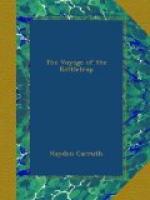We worked for an hour, and managed to fill one bag with “nubbins,” and gave up, promising ourselves that we wouldn’t be imposed upon in that way again.
We reached Chadron in due time, and went into camp a little way beyond, on the banks of the White River, a stream which flows through Dakota and finally joins the Missouri. Our camp was on a little flat where the river bends around in the shape of a horseshoe. It seemed to be a popular stopping-place, and there were half a dozen other covered wagons in camp there. The number of empty tin cans scattered about on that piece of ground must have run up into the thousands. But there had not been a mile of the road since we left Valentine which had not had from a dozen to several hundred cans scattered along it, left by former “movers.” We had contributed our share, including the gooseberry can. From the labels we noticed on the can windrow along the road it seemed that peaches and Boston baked beans were the favorite things consumed by the overland travellers, though there were a great many green-corn, tomato, and salmon cans.
“You can get every article of food in tin cans now,” observed Jack one day, “except my pancakes. I’m going to start a pancake cannery. I’ll label my cans ’Jack’s Celebrated Rattletrap Pancakes—Warranted Free from Injurious Substances. Open this end. Soak two weeks before using.’”
It was a pretty camping-place on the little can-covered fiat, and we sat up late, visiting with our neighbors and talking about the Black Hills.
“I think,” said Jack, as we stumbled over the cans on our way to the Rattletrap, “that I’ll go into the mining business up there myself. I’ll just back the Blacksmith’s Pet up to the side of a mountain, tickle his heels with a straw, and he’ll have a gold-mine kicked out inside of five minutes.”
IX: OFF FOR THE BLACK HILLS
The next day was Sunday, so we did not leave the White River camp till Monday morning. We found Chadron (pronounced Shadron) an extremely lively town, in which all of the citizens wore big hats and immense jingling Mexican spurs. We had the big hats, but to be in fashion and not to attract attention we also got jingling spurs.
“I shall wear ’em all night,” said Jack, as he strapped his on. “Only dudes take off their spurs when they go to bed, and I’m no dude.”
Our next objective point was Rapid City. It was a beautiful morning when we turned to the north. The sand had disappeared, and the soil was more like asphalt pavement.
“The farmers fire their seed into the ground with six-shooters,” said a man we fell in with on the road. “Very expensive for powder.”
“The soil’s what you call gumbo, isn’t it?” I said to him.
“Yes. Works better when it’s wet. One man can stick a spade into it then. Takes two to pull it out, though.”




